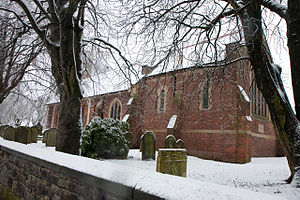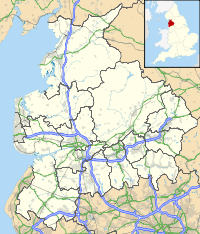- St Paul's Church, Farington
-
St Paul's Church, Farington 
St Paul's Church, Farington, from the southeastLocation in Lancashire Coordinates: 53°43′12″N 2°42′04″W / 53.7199°N 2.7012°W OS grid reference SD 538 250 Location Farington Moss, Lancashire Country England Denomination Anglican Website St Paul, Farington History Dedication St Paul Consecrated 27 June 1849 Architecture Status Parish church Functional status Active Heritage designation Grade II Designated 11 November 1966 Architect(s) Edmund Sharpe
J. A. SewardArchitectural type Church Style Romanesque, Gothic Revival Groundbreaking 1839 Completed 1910 Construction cost £1,700
(£120,000 as of 2011)[1]Administration Parish Farington Moss, St Paul Deanery Leyland Archdeaconry Blackburn Diocese Blackburn Province York Clergy Vicar(s) Revd Margaret Rimmer Assistant priest Rev D. A. Baines Laity Churchwarden(s) Mrs H. A. Yeadon
S. NapierParish administrator G. Napier St Paul's Church, Farington, is in the village of Farington Moss, Lancashire, England. It is an active Anglican parish church in the deanery of Leyland, the archdeaconry of Blackburn and the diocese of Blackburn. Its benefice is united with that of St James, Lostock Hall.[2] The church has been designated by English Heritage as a Grade II listed building.[3]
Contents
History
St Paul's was built in 1839–40 and designed by the Lancaster architect Edmund Sharpe.[4] The church cost £1,700 (£120,000 as of 2011)[1] to build and £500 of this was met by a grant from the Church Building Commission.[5] It is a Commissioners' church.[6] The church was consecrated on 27 June 1849 by Rt Revd John Bird Sumner who was at that time the Bishop of Chester. In 1909 it was enlarged by adding an extra bay to the nave and increasing the size of the chancel, the architect being J. A. Seward of Preston. The addition had resulted in a higher roof for the chancel, and in 1966 the nave roof was raised to the same level as the chancel.[7]
Architecture
The church is built in brick with stone dressings and a red tile roof. The tower and nave are in Romanesque style and the chancel is in Gothic Revival style. Its plan consists of a six-bay nave, a chancel, and a northwest tower. The tower has four stages, with angle buttresses rising to a pinnacle at each corner. In the bottom stage are arched doorways; above this each stage contains a pair of round-headed windows. The windows in the first floor are glazed; those above are louvred.[3]
See also
- List of architectural works by Edmund Sharpe
- List of Commissioners' churches in Northeast and Northwest England
References
- ^ a b UK CPI inflation numbers based on data available from Lawrence H. Officer (2010) "What Were the UK Earnings and Prices Then?" MeasuringWorth.
- ^ Farington Moss, St Paul, Church of England, http://www.achurchnearyou.com/farington-moss-st-paul/, retrieved 27 July 2011
- ^ a b "Church of St Paul, Farington", The National Heritage List for England (English Heritage), 2011, http://list.english-heritage.org.uk/resultsingle.aspx?uid=1073032, retrieved 14 May 2011
- ^ Hartwell, Clare; Pevsner, Nikolaus (2009) [1969], Lancashire: North, The Buildings of England, New Haven and London: Yale University Press, p. 289, ISBN 978-0-300-12667-9
- ^ Port, M. H. (2006), 600 New Churches: The Church Building Commission 1818-1856 (2nd ed.), Reading: Spire Books, p. 334, ISBN 978-1-904965-08-4
- ^ Price, James (1998), Sharpe, Paley and Austin: A Lancaster Architectural Practice 1836–1942, Lancaster: Centre for North-West Regional Studies, p. 68, ISBN 1-86220-054-8
- ^ Hughes, John M. (2010), Edmund Sharpe: Man of Lancaster, John M. Hughes, p. 125
Categories:- Church of England churches in Lancashire
- Grade II listed churches
- Grade II listed buildings in Lancashire
- Romanesque Revival architecture in England
- Gothic Revival architecture in England
- Commissioners' churches
- 19th-century Church of England church buildings
- Anglican congregations established in the 19th century
- Religious buildings completed in 1910
- Diocese of Blackburn
- Edmund Sharpe buildings
- Buildings and structures in South Ribble
Wikimedia Foundation. 2010.

